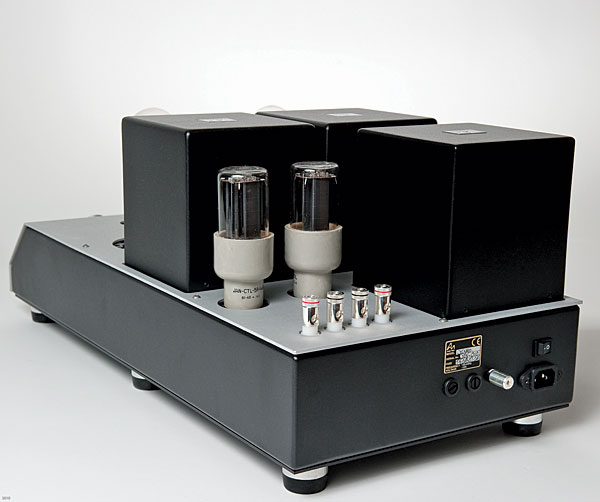| Columns Retired Columns & Blogs |
Drop dead gorgeous!
The Jinro rests on six feet: When you weigh 85 lbs and stand only 11" tall—but a full 26" long!—four feet just won't do.

Installation and setup
In fact, the size and weight of the Audio Note Jinro combine to create a big problem of little consequence: Where does a 85-lb, 26"-long amplifier sit?
Anywhere it likes, I suppose—or, put another way, any location to which one can carry it without opening old wounds. So it was with my review sample of the Jinro, which was delivered to me by Dave Cope of Triode & Co., who works for Audio Note as one of the manufacturer's US representatives. Dave brought the big Audio Note amp in the back of his Volvo station wagon, and he and I carried it inside my house together, as befits any home furnishing too long and too heavy to cuddle in the arms of one man.
I love my home and I love my furniture—and I especially love audio gear that accommodates rather than confounds those things. But in this case, reason prevailed. And because there were clearly good reasons for the Jinro's weight and size—no space is wasted inside its sheet-metal chassis, and its extraordinary weight is accounted for not by a stupid-thick faceplate but by the necessary metal content within all those transformers—I happily let the Jinro sleep on the hardwood floor, next to instead of atop my Box Furniture D3S rack.
Luckily for me, long speaker cables are a normal part of my reference-system setup, and my 20' pair of tube-happy Auditorium 23 speaker cables (stranded copper sheathed in fabric and terminated with gold-plated banana plugs) seemed perfectly happy with these tubes. Interconnects were a mix of Audio Note AN-Vx silver Litz—enduringly wonderful stuff that I bought over a decade ago and still love—and Shindo Silver. The power cord that came with the Jinro seemed sufficiently hefty that I didn't try any accessory AC cords. My analog sources were my Thorens TD 124 and Garrard 301 turntables with various tonearms and pickup heads, aided in their task by the phono sections of my Shindo Masseto preamp and a borrowed Shindo Vosne-Romanee preamp, and by a borrowed LFD Phono LE phono preamp, set for moving-magnet gain and impedance—all with a variety of step-up transformers. Digital sources were my Sony SCD-777 SACD/CD player and my Apple iMac–iTunes installation driving a variety of USB D/A converters (but mostly a borrowed Furutech GT40).
For the most part, of course, I used the Audio Note Jinro with my own Audio Note AN-E SPe H/E loudspeakers: a reasonable enough pairing, I should think. In fact, as you'll see in a moment, the two worked together quite well. I was mildly disappointed not to be able to say the same of the combination of the Jinro and my own Quad ESLs: The sound of that system flattered neither product. Given the Quads' wiggy impedance curve and the Audio Note's utter lack of feedback, local or global, I was not surprised.
During its time in my home, the Audio Note Jinro behaved flawlessly: no hum, no crackle noises, no service interruptions. And the curtains never once caught on fire.
Listening
I loved the Audio Note Jinro. Its overall sound was very subtly sweet, with a midrange that was a bit soft—timbrally, but not temporally—with an abundance of that often-noted-yet-never-explained "SET sound" that allows solo voices and instruments to stand musically and spatially proud of the rest of the mix. The Jinro played melodies with unsurpassed flow and momentum, including those in Elgar's Sospiri, recorded by Paul Goodwin and the English Chamber Orchestra (AIFF file ripped from CD, Harmonia Mundi HMU 907258), and allowed even the most up-tempo music—the Replacements' Sorry Ma, Forgot to Take Out the Trash (LP, Twin Tone TTR 8123) comes to mind—to sound nearly as propulsive as through, say, a Naim Nait. Yet the Jinro distinguished itself by allowing notes a realistically generous amount of natural decay—again, without the slightest sense of rhythmic lagging.


Every blossom in spring is as perfect as need be.
We enjoy racing our pet turtles, but, the magic is lost on them.
What was your favorite note in the song that just finished?
Streamer really pulls the music free of its digital dungeon.
Hurrah!